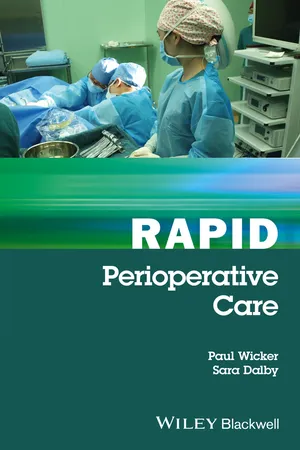Chapter 1
The Role of the Anaesthetic Practitioner
An anaesthetic practitioner is an essential member of the operating department team working alongside anaesthetists, surgeons, practitioners and healthcare support workers to ensure that anaesthesia for the patient is as safe and effective as possible. Anaesthetic practitioners provide high standards of patient care and skilled support alongside the other members of the perioperative team during the perioperative phases before, during and after surgery (Fynes et al. 2014). It is also essential that they continue with updates and attend current in-house training to maintain their skills and knowledge.
The role of the anaesthetic practitioner has nationally agreed standards and levels of practice, implemented by the Royal College of Anaesthetists (RCA 2006). An anaesthetic practitioner's roles are also covered by the College of Operating Department Practitioners and the Health Care Professions Council. Hospital regulations manage these standards appropriately and are implemented within a nationally recognised framework (Fynes et al. 2014).
The roles and responsibilities of anaesthetic practitioners include working by themselves to prepare equipment and providing care for the patient, as well as offering support to the anaesthetist during all stages of anaesthesia (Fynes et al. 2014). The main roles and responsibilities of the anaesthetic practitioner include:
- To deliver psychological and emotional support to the patient
- To check the anaesthetic machine
- To prepare the anaesthetic equipment
- To support the patient throughout the stages of anaesthesia
- To support the anaesthetist during anaesthesia
- To understand responsibility and accountability for the patient during anaesthesia, including patient documentation, for example the consent form and the World Health Organization (WHO) Surgical Safety Checklist.
Preanaesthetic phase
The anaesthetic practitioner assists the patient before surgery and provides individualised care. This will include supporting the patient by reducing anxiety, placing blood pressure cuffs, connecting electrocardiograph (ECG) electrodes and pulse oximeters, and preparing IV fluids and anaesthetic drugs (NHS Modernisation Agency 2005). The practitioner will also communicate effectively within the team to pass on problems, issues or any past adverse events, such as when catheterising patients and when preparing and assisting in the safe insertion of invasive physiological monitoring such as central venous pressure (CVP) lines and arterial lines.
The anaesthetic practitioner is also able to support the patient if he or she has any concerns. For example, most patients fear anaesthesia, because of fearing the risk of waking up too early or not waking up following surgical procedures. Many patients ask, ‘Will I wake up alright after surgery?’ and then become anxious if they don't receive a reply. One of the main roles is therefore to provide psychological support, which is something that practitioners can do on a face-to-face basis. This may include discussing problems, offering reassurance to the patient to let them know they are monitored safely, ensuring the patient is comfortable, talking to the patient and reassuring the patient throughout their time in theatre (Fynes et al. 2014).
The anaesthetic practitioner will also undertake roles which will also involve many clinical skills, such as preparing a wide range of specialist equipment and drugs (Copley 2006). This includes:
- Testing anaesthetic machines
- Preparing anaesthetic equipment (AAGBI 2012)
- Preparing intravenous equipment
- Making devices available to safely secure the patient's airway during anaesthesia
- Ensuring drugs such as propofol, local anaesthetics, anaesthetic gases and so on are available
- Knowledge of the different operating tables, including positioning equipment, clamps and pressure-relieving devices.
Anaesthesia
There are three parts to anaesthesia:
- Induction: This is when the patient goes to sleep using anaesthetic drugs.
- Maintenance: This is maintaining the anaesthetic during surgery.
- Reversal: This is wakening the patient up by stopping the administration of drugs and anaesthetic gases, or by using specialist drugs to revive the patient (Goodman & Spry 2014).
Responsibility of the practitioner for the care of the patient throughout the stages of anaesthesia is vitally important (Fynes et al. 2014). The practitioner is responsible for ensuring the patient is positioned correctly to maintain safety and comfort, to ensure pressure areas are supported, and also to provide maximum access during the operative procedure. The practitioner also needs to follow legal and ethical considerations, and ensure that they are following the Health and Care Professions Council (HCPC) regulations and guidelines.
Checking the anaesthetic machine
Making sure the anaesthetic machine is working correctly is an essential part of the anaesthetic practitioner's role, in collaboration with the anaesthetist. Knowing ‘how’ it works is of course equally important (Goodman & Spry 2014). During induction of anaesthesia, the patient is at one of the most vulnerable points in his or her perioperative care. Equipment error can therefore put the patient at high risk of harm, for example through airway obstruction, circulatory problems, reduced blood oxygenation or even death, because of errors such as flow reversal though the back bar on the anaesthetic machine (Smith et al. 2007).
Practitioners should check the anaesthetic machines by using the Association of Anaesthetists of Great Britain and Northern Ireland checklist (AAGBI 2012) and the manufacturer's manual as guides to ensure the machine is safe to use. There is a joint responsibility between the anaesthetist and anaesthetic assistant for ensuring the correct functioning of anaesthetic equipment before patient use. Often, the anaesthetic assistant will assemble and check the equipment in preparation for the anaesthetist, who then ensures that he or she h...
